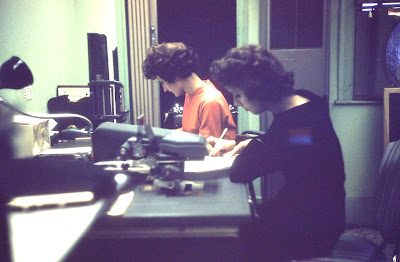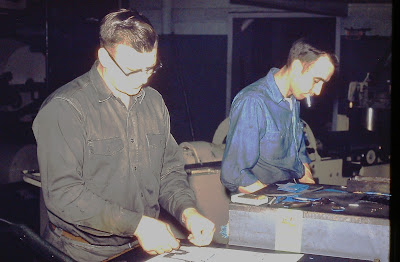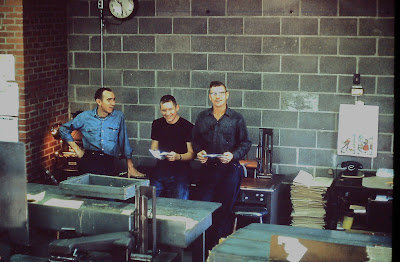In 2018, I shared a sketch that explored Ralph’s role as a projectionist at Warner’s Skyline Drive-In Theater in Clarksburg, West Virginia. Today I will delve into another aspect of Ralph’s career: his 30-year tenure with Addressograph Multigraph Corporation (AMC), where he specialized in repairing addressograph machines.
Within Ralph’s photo archive, I discovered a collection of intriguing images. Some depict an office setting, while others seemed to be taken in a factory, surrounded by an array of machines. Additionally, there are photos from two holiday parties, all featuring the same group of people. Given the frequent family references to Ralph’s occupation as an addressograph machine serviceman, I could not help but wonder if these images were somehow linked to his work. With that thought in mind, I conducted a quick online search of addressograph machines and discovered images of a machine like the one captured in the photo below. This discovery confirmed my suspicion and inspired the creation of this sketch.
Now I wanted to learn more about the addressograph machine and AMC in general. I also wanted to know more about Ralph’s role and where he performed those duties. Did he work from a corporate office or factory, and if so, from where, in what city? Or did he work remotely like many people do today, traveling between various locations?
According to Microsoft Copilot, a generative AI chatbot powered by Bing, the Addressograph International Corporation was established in Chicago, Illinois in 1893 to manufacture an envelope-addressing service. The American Multigraph Company was founded in 1902 to produce a machine that could duplicate letters. In 1932, the Addressograph International Corporation and the American Multigraph Company merged, forming AMC. This merger resulted in the production of highly efficient addressograph and duplicating machines. AMC’s growth was significant, and by 1967, had 27 subsidiaries. In the late 1960s and 1970s, AMC’s growth slowed due to challenges in keeping up with fast-paced technology. In 1978, the corporate headquarters moved from Ohio to California; they changed its name to AM International in 1979. By 1980, sales declined, leading to the company filing for bankruptcy in 1982. Its impact on addressing technology was significant; “The Addressograph was a marvel of its time, designed to streamline the laborious process of addressing envelopes, cards, statements, and payroll forms. … The Addressograph revolutionized office efficiency, making it possible to address thousands of envelopes per hour. It paved the way for direct mail marketing (yes, even “junk mail”).” To learn more about the origins of the Addressograph Company, visit the Made in Chicago Museum website.
Among the artifacts passed down to my husband by his Aunt Jean was Ralph’s AMC employee identification card, which indicated his hiring date of December 1, 1952. During that period, Ralph resided in Nutter Fort, but he would later relocate to Bridgeport—both towns lying within a five-mile radius of Clarksburg. Although the above history of AMC does not mention an office in West Virginia, was there one somewhere in the Clarksburg area?
After conducting thorough research using online resources including city directories, it became clear that AMC did not have an office in the area. However, I did see individuals who were employed by AMC listed in the city directories. Simultaneously, I reached out to dedicated volunteers from the Clarksburg History Museum. Despite their efforts in checking local resources and consulting with long-time Clarksburg residents, they were unable to find any relevant information. Nevertheless, they were able to confirm other details.
The Clarksburg city directories did provide clear evidence that Ralph worked at AMC and serviced addressograph machines, but I had to review multiple directories before the company was listed. Ralph appeared in the 1946 and 1948 directories, employed as a carbon worker, but the identity of his employer was not listed. With no clue what a carbon worker did, I again turned to Microsoft Copilot where I learned a carbon worker “would have been responsible for a crucial step in the process of creating address labels and other printed materials.” A carbon worker typed or embossed recipient names and addresses onto addressograph cards rather than paper. The cards would then be processed through the addressograph machine for mass mailings. Another possibility would be that Ralph worked for Union Carbide in Anmoore, West Virginia (near Nutter Fort) where he would have been responsible for tasks related to carbon production and processing. This would involve operating machinery, monitoring processes, and handling raw materials (such as coal or petroleum coke) to create carbon-based products. But we have no way at this time of knowing which is correct. [Thanks, Marilyn, for suggesting Union Carbide as a possibility.]
In 1950, Ralph worked as a projectionist, which we know is Skyline Drive-In. The 1951 directory was not available, but in 1952, he worked as a “belm opr.” Again, with no clue what that meant, I found an answer using Microsoft Copilot. A BELM OPR worked behind the scenes to ensure the addressograph machine ran smoothly. “Their attention to detail, speed, and accuracy contributed to efficient office operations.” As skilled workers, their role was crucial “in operating the Addressograph machines.” This means Ralph would have been responsible for “loading metal cards (with recipient information) into the machine, ensuring proper alignment, and activating the stamping process,” making “necessary adjustments or perform minor maintenance tasks” if the “machine encountered issues (such as misalignment, ink smudging, or card jams), and replacing the “ink ribbon (similar to a printer cartridge)” when it ran low. He would have also “ensured that the embossed metal cards contained correct recipient names and addresses” and “monitored the stamping process to ensure legibility and consistency across envelopes and other materials.” All this would have been done while the machine addressed “thousands of envelopes per hour.” Finally, Ralph would have been responsible for maintaining the embossed metal card catalog which was “alphabetically sorted and stored in filing trays,” ensuring he could efficiently retrieve “a specific recipient’s information” when needed by the machine.
My brother-in-law Pat has fond but somewhat hazy memories of accompanying Ralph to work on several occasions when visiting with him and Jean. Pat recalls large machines with a prominent cylindrical component through which envelopes were fed for printing. He remembers seeing metal or tin plates equipped with a keyboard. During one visit, they witnessed the process of punching out data cards. In the photo below, a large machine prominently displays the word “GOSS” on its side (perhaps like what Pat remembers). The Goss Printing Press Company (GOSS) specialized in manufacturing printing presses. These presses were responsible for producing a wide range of materials, including newspapers, magazines, and books. Ralph must have taken this photo where he worked or visited to repair the machines.
Pat also remembers that Ralph’s garage held stacks of boxes, each containing hundreds of blank metal plates. The boxes were white, adorned with a green AM logo stamped on them. Another memory involved visiting four different gas stations over multiple days. Ralph’s task was to replace metal plates that contained the business information of each respective company. These plates were used in a credit card imprinter, also known as a “click-clack” machine for generating receipts. You might recall this device: it involved placing a credit card inside and then pressing the handle downward to create an impression on a receipt. These receipts typically consisted of three layers of paper, with carbon paper interleaved between them. The gas station retained one copy, another went to the credit card company for reimbursement, and the customer received their own copy. I recently wrote a sketch about Augie’s Pure Oil Service Station in Nutter Fort. As Pat recalled the gas stations, I wondered if one might have been Augie’s. As far as Pat can recall, their activities remained localized to Clarksburg and Bridgeport.
While both a carbon worker and a BELM OPR were suitable positions for employees at AMC, the dates associated with the employee ID card did not align, prompting more research on my part. In the 1954–1956 Clarksburg city directories, Ralph’s occupation was consistently listed as a ‘serviceman,’ aligning with what my husband knew.
Ralph and Jean labeled many slides in their collection. Among the slides dated for the year 1956, several were specifically labeled as the “Addressograph Christmas Party 1956.”
One photo provided a vital clue regarding the location of the party—a menu from the Chatterbox Sandwich Shop. This small restaurant, located on West Pike Street in the Adamston community of Clarksburg, was described as a restaurant and confectionery that served a variety of legal beverages. After their shift ended, it is quite possible that employees of the Adamston Flat Glass company stopped by for a beer before heading home. However, over time, it has become better known as a hot dog stand with a bar, close to the roadside. In the photo below, you can spot two of the attendees holding the Chatterbox menu.
You can also spot a jukebox in the background—a relic that was all the rage in 1956. Close your eyes, and you can almost hear the soulful tunes of Elvis Presley, the melodies of The Platters, the timeless voice of Doris Day, the smooth crooning of Dean Martin, and the jazzy orchestrations by Nelson Riddle. Picture Carl Perkins’ rockabilly guitar riffs, the rollicking piano of Fats Domino, and the electrifying energy of Gene Vincent. All nostalgic music that transports you to a time of unforgettable music. The employees in the below photos may have been enjoying those very tunes that evening.
 |
Ralph is standing in the center of this photo |
The next year, 1957, Ralph was recorded as an ‘engraver’ in the city directory. In 1960, he was once again recorded as a ‘serviceman,’ but this time, the directory included his employer as “Addressograph Multigraph Corporation.”
On December 16, 1960, the office once again celebrated the holiday season, this time at the office. We know the specific date because Ralph or Jean labeled the slides “12/16/60 AM office party” on the slide box label.
In this first photo, you may recognize the woman sitting on the desk as one featured in several of the 1956 party photos. Also, if you look closely, you will spot a clue regarding the company name. I zoomed in on the white sheet of paper on the left side of the wall and could see three words that appear to be “Addressograph Multigraph Corporation.”
I know this is very blurry, but do you see the same?
The next series of photos were taken at the 1960 Christmas party. I would venture to say most of the employees lived within the vicinity of Clarksburg, Bridgeport, and Nutter Fort.
 |
Ralph and two unknown women |
Ralph took several other photos at this office or factory. Some may have been taken during the Christmas party while others were likely taken another time.
In 1977, Ralph received “Technical Representative of the Month” awards in January and April. You can see an “AM” logo on both awards. Although not green, was this the same AM logo my brother-in-law remembered? Was AM connected to AMC?
Ralph celebrated his 25th year of employment on December 1, 1977. To mark this significant milestone, he was presented with an engraved wristwatch. Unfortunately, neither the watch nor the accompanying box revealed the company responsible for this gift.
On November 23, 1982, Ralph received a letter of commendation and a pewter coffee set from Addressograph Farrington Inc. (AFI) celebrating his “thirty years good service.” The company letterhead indicated AFI was in Randolph, Massachusetts.
Near the bottom of the page, you see the letter was addressed to Mr. Ralph Murphy of AFI. The specified address is 500 North Bell Avenue, Carnegie, PA. To our knowledge, Ralph never resided in Pennsylvania, although records indicate that AFI was situated at that address at some point in time.
AFI was established by Sterling Elliot in the late 1800s. It created its own addressing machine, first sold in 1900. Elliott relocated the factory to Cambridge, Massachusetts in 1911. Ownership changed hands, leading AFI through various rebrandings and relocations. Eventually, it became part of DataCard in 1986, closing its doors in 1987. Although both have links to the addressograph machine, I have found no direct association between AFI and AMC or to the Clarksburg area.
The last piece of the puzzle is a business card for JDM Service Company, an artifact of Ralph’s. JDM Service Company was an Addressograph-Bruning Service owned by Jean with Ralph as a consultant. This service would have been responsible for the same tasks mentioned above in working with an addressograph machine. They operated JDM out of their home, although the dates are unknown to us.
As Henry Louis Gates says on Finding Your Roots, the paper trail ended with the business card. While I have no record showing a connection linking AMC, AM or AFI, there must be one somewhere, otherwise, how could Ralph celebrate a 30-year career? Also, as I followed the trail of clues, specific events and dates came into focus. However, the mystery of Ralph’s workplace remains unsolved. It is unclear whether he was assigned to a specific city, worked from an office or factory, or split his time between various locations, so this is unfinished business.
I hope you enjoyed this group of photos from Ralph’s archives. To see others from his collection, click here.
References
- Addressograph Company, est. 1893, Made in Chicago Museum; https://www.madeinchicagomuseum.com/single-post/addressograph-co/.
- Addressograph; https://en.wikipedia.org/wiki/Addressograph.
- Addressograph-Multigraph Corp., hobbyDB; https://www.hobbydb.com/marketplaces/hobbydb/subjects/addressograph-multigraph-corp-company.
- AM International, Inc., Encyclopedia of Cleveland History, Case Western Reserve University; https://case.edu/ech/articles/a/am-international-inc.
- Clarksburg, West Virginia, City Directory, 1944, 1946, 1948, 1950, 1952, 1954, 1957, 1960.
- History, Goss Printing Press Co., Vintage Machinery; http://vintagemachinery.org/mfgindex/detail.aspx?id=10894.
- Innovation in Cambridge, Addressing Machine; https://historycambridge.org/innovation/Elliot%20Addressing%20Machine.html.
- Microsoft Copilot, a generative AI chatbot powered by Bing.
- Personal artifacts of Ralph Murphy.
- Personal memories of Clarksburg History Museum volunteers and Pat Murphy.











































Addressograph headquarters were in Euclid ,Ohio a suburb of Cleveland Ohio from 1932 to 1978.The company in Euclid was closed in 1982.
ReplyDelete